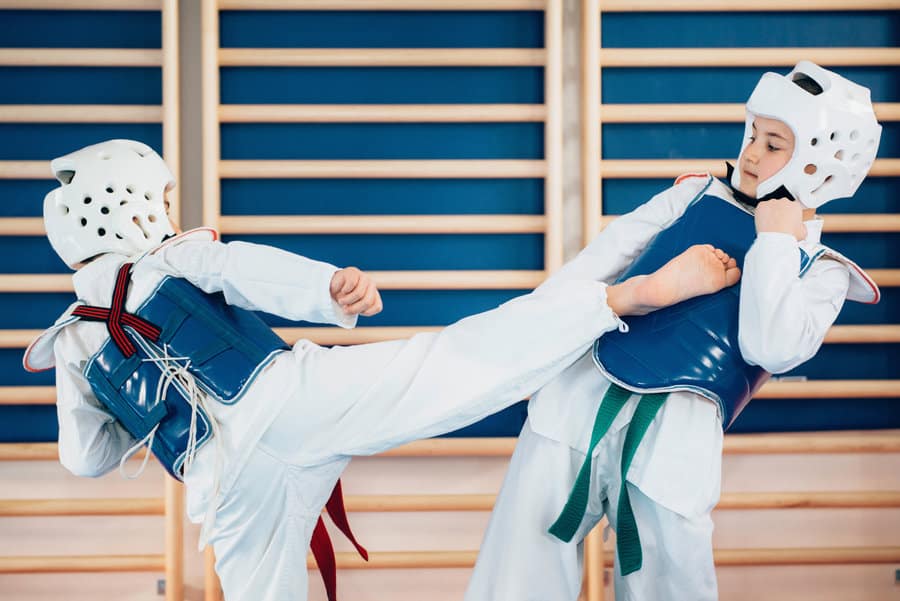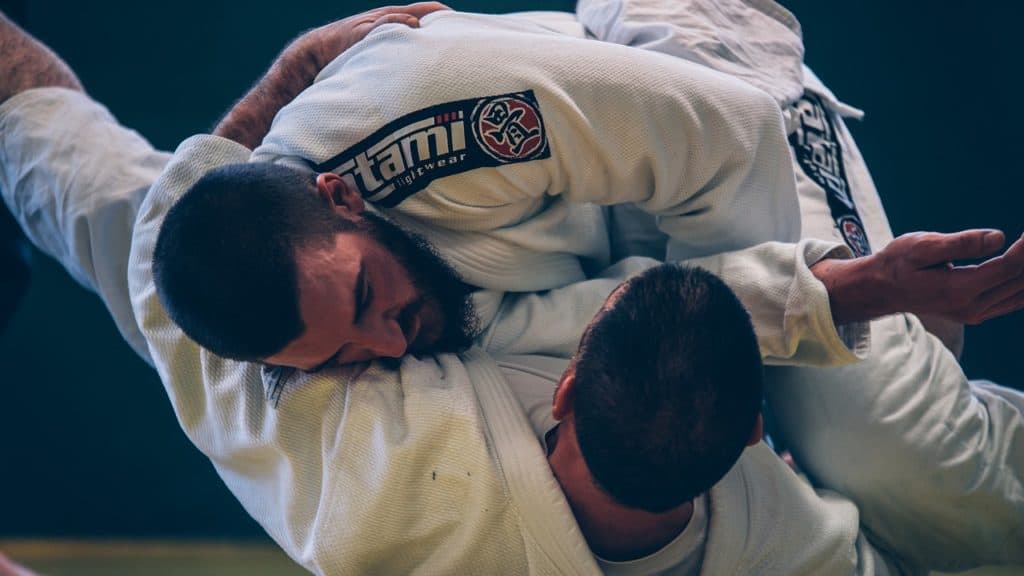
If you are a beginning TaeKwonDo Student and are starting to learn One Step Sparring then you have probably wondered what is the purpose of it. Having been studying TaeKwonDo for a few years now, I also wondered what was the purpose one step sparring was.
It essence One Step Sparring is a controlled scenario that helps Taekwondo students develop proper technique and know how to react in a real life situations.
TaeKwondo is also known for having different styles of sparring implemented in the training. One usually overlooked method is one step sparring. It is a great training approach and I am going to breakdown its history and how it is performed.
What Is One Step Sparring?
One step sparring is a choreographed display in TaeKwondo, where a practitioner performs a self defense technique in one step. A student goes through a list of specific one step counter techniques that they were taught in training.
History of One Step Sparring in TaeKwonDo
The history of TaeKwondo one step sparring is actually less than a 100 years old and has interesting influences. It was actually created by a karate instructor in the 1930’s.
Gigo Funakoshi, the son of the founder of Shotokan karate Gichin Funakoshi is generally credited for being the inventor. He also studied kendo and wanted to incorporate the methods he practiced into karate.
In kendo, you perform long distance fencing drills, where you counter the attacks of your partner. Gigo wanted to implement this style of drilling into karate. So, he had students stand one step apart and they would perform a choreographed display of self defense.
The idea Gigo had creating one step sparring was that the movements mimic’d real life situations. Your partner would come at you with an attack and you perform a defensive move to counter it.
General Choi, one of the creators of TaeKwondo also believed in the approach of one step sparring. He believed that is was the closest thing to an actual self-defense situation. Today multiple organizations have guidelines to perform one step sparring drills and each school has their own list of combinations.
In Korean, the name for one step sparring is “Ilbo Matsogi.”
How Is One Step Sparring Performed?

Here is a list of how a one step sparring drill is performed.
- First, the student performing the drill stands a foot away from his partner. Both bow to each other and then get in the ready stance waiting for their instructor to give the cue to start.
- The instructor yells a certain word that cues the performer and his partner. The two respond by yelling EYA signaling they are both ready.
- The partner throws an attack at the performer and they block it and counter with a certain attack pattern.
- They then bow to each other and go through the steps again until they perform all of the attack patterns in the set they learned.
The Purpose of One Step Sparring In TaeKwonDo
One step sparring was developed as a tool to help students learn basic to advanced techniques. It is especially good for beginner students learn in helping learn these aspects of taekwondo.
The purpose of one step sparring is to mimic a real life situation, where you would use specific techniques you practiced in training. It is also generally used for belt tests to test the skill and knowledge of the student.
How Does It Help You In Taekwondo?
| Timing | Through one step sparring a student can learn timing and understand when is the proper time to use techniques |
| Distance and Range | They will begin to understand distance in sparring and know that they need to be in specific ranges to execute attacks |
| Muscle Memory | Through practicing these patterns repeatedly in training, they will naturally perform them in one step sparring. |
| Confidence | Students build confidence in their ability to do the techniques performing them in a controlled scenario. |
Training For One Step Sparring
Training for one step sparring is about the same as you would train for anything else. You train for the situation and go through a list of attack patterns that the academy teaches. It is just like how you would practice any other techniques
One Step Sparring Vs Free Form Sparring

In types of free form sparring like point sparring and full contact sparring. There are no set list of moves giving. When the instructor or referee says go, the two people sparring throw techniques at random for the allotted time.
One step sparring is a choreographed act of performing a set list of self-defense moves. In reality it isn’t actually sparring. It is more similar to a kata since the moves are also pre-patterned in that discipline.
It is also a limited contact drill, where you block the attack, but don’t actually strike your partner with the counter. You perform the counter without actually touching your partner besides the block.
One Step Sparring And TaeKwonDo Belt Testing
Belt tests in Taekwondo can include one touch sparring in the testing process. Their knowledge, as well as the skill of how they perform counter attacks is put to the test. They’re asked to perform a specific list of counter attacks and could advance to a higher belt depending on their performance.
Lower belt students perform less complicated moves and difficulty gradually goes up the higher the belt rank.
Examples Of One Step Sparring In Belt Testing
Below is an example of what a student could be asked to perform during one step sparring.
- Perform 5 counter attacks off a straight punch
- Perform 5 counter attacks off a sidekick
- Perform 5 counter attacks off a front kick
- Perform 5 counters attacks off a takedown attempt
If a student can remember these movement patterns and perform them well, they can advance to the next belt. Of course their advancement also depend on the other requirements of a school. Live sparring round, Poomsae, etc.
One Step Sparring By TaeKwonDo Organization

Each Taekwondo organization has their own guidelines and list of techniques for one step sparring.
- ATA: The American TaeKwondo Association’s guidelines for one step sparring is for beginners to progress through combinations in 1/2/3 step sparring. Students that show progression are then allowed to free spar.
- ITF: The International TaeKwondo Federation’s guidelines are similar to the guidelines of ATA, where they have set lists of combinations that get more advanced as student’s progress.
- WT: World TaeKwondo (Kukkiwon) schools generally don’t use one step sparring, because their training is more geared for sport competition but in my school, we do practice one step sparring .
Different Taekwondo schools also make up their own list of combinations students need to perform to progress.
Evolution Of One Step Sparring in TaeKwonDo
During the description of one step sparring in belt test it was noted that higher belts do more complicated techniques.
Obviously this means that one step sparring has evolved into more complicated variations. Below are the types of one step sparring going from basic to the hardest level with descriptions of each.
- Traditional one step sparring: A student counters one attack and may be required to perform it on both sides.
- Two step sparring: A student has to block two different attacks before countering their partner.
- Three step sparring: A student has to block three consecutive attacks before countering their partner.
- One step sparring(not pre-arranged): This is considered the most advanced for of step sparring. The attacker may use any attack they wish that isn’t in the usual pattern and the student must counter.
- Counter and recounter step sparring: Same principle as the other forms, but after the student counters, they must defend another counter and re-counter. This type is generally for more advanced belts.
One Step Sparring In Other Martial Arts

One step sparring is not just used in styles of Taekwondo and Karate. The principles of one step sparring have influenced jiu jitsu and judo schools to implement similar aspects into their belt testing processes. Like in Taekwondo, the students are put on the spot and must perform techniques in front of the instructor.
Here is a quick example of how aspects of one step sparring could be used in jiu jitsu during belt tests:
- Demonstrate 3 submissions from closed guard.
- Demonstrate 3 sweeps from guard.
- Demonstrate 3 guard passes.
- Demonstrate 3 takedowns.
Some judo schools also use a similar guideline for students to demonstrate proper techniques in different scenarios.
Tips For Practicing One Step Sparring
There are some many good approaches to training the movements in one step sparring. Most of the practicing is either done with a partner or on your own doing solo drills. Here are a few tips to help you in learning the movements.
- Break up the movements: Instead of practicing the entire pattern, you can break it up into segments. Drill the steps, blocks, and attacks separate, then put them all together after you got down all of the movements.
- Footwork drills: Drills can be developed to learn the footwork involved in each pattern. Use cones or tape on the mat to mark where each step is supposed to be placed.
- Shadow Boxing: Nearly every striking martial art uses shadow boxing to practice movements. Do shadow boxing in front of a mirror, so you can see how you are performing the movements and fix mistakes you see.
Final Thoughts
I hope this breakdown of what one step sparring is and how it is performed in Taekwondo has been helpful. Its as important to practice with the same effort as you do your Poomsae or Free Sparring as it all goes hand in hand with your overall training and each is important in its own wayy

